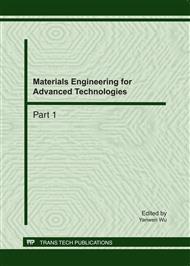[1]
J. H. Brandts and M. Krizek: History and future of superconvergence in three dimensional finite element methods, Proceedings of the Conference on Finite Element Methods: Three-dimensional Problems, GAKUTO International Series Mathematics Science Application, Gakkotosho, Tokyo, 15 (2001).
Google Scholar
[2]
J. H. Brandts and M. Krizek: Gradient superconvergence on uniform simplicial partitions of polytopes, IMA J. Numer. Anal. 23 (2003), 489–505.
DOI: 10.1093/imanum/23.3.489
Google Scholar
[3]
J. H. Brandts and M. Krizek: Superconvergence of tetrahedral quadratic finite elements, J. Comput. Math. 23 (2005), 27–36.
Google Scholar
[4]
C. M. Chen: Optimal points of stresses for the linear tetrahedral element (in Chinese), Nat. Sci. J. Xiangtan Univ. 3 (1980), 16–24.
Google Scholar
[5]
C. M. Chen: Construction theory of superconvergence of finite elements (in Chinese), Hunan Science and Technology Press, Changsha, China, (2001).
Google Scholar
[6]
L. Chen: Superconvergence of tetrahedral linear finite elements, Internat. J. Numer. Anal. Model. 3 (2006), 273–282.
Google Scholar
[7]
G. Goodsell: Gradient superconvergence for piecewise linear tetrahedral finite el- ements, Technical Report RAL-90-031, Science and Engineering Research Council, Rutherford Appleton Laboratory, (1990).
Google Scholar
[8]
G. Goodsell: Pointwise superconvergence of the gradient for the linear tetrahedral element, Numer. Methods Partial Differential Equations 10 (1994), 651–666.
DOI: 10.1002/num.1690100511
Google Scholar
[9]
V. Kantchev and R. D. Lazarov: Superconvergence of the gradient of linear finite elements for 3D Poisson equation, B. Sendov, editor, Proceedings of the Conference on Optimal Algorithms, Bulgarian Academy of Sciences, Sofia, 1986, p.172–182.
Google Scholar
[10]
Q. Lin and N. N. Yan: Construction and analysis of high efficient finite elements (in Chinese), Hebei University Press, Baoding, China, (1996).
Google Scholar
[11]
R. C. Lin and Z. M. Zhang: Natural superconvergent points in 3D finite elements, SIAM J. Numer. Anal. 46 (2008), 1281–1297.
Google Scholar
[12]
J. H. Liu and Q. D. Zhu: Uniform superapproximation of the derivative of tetra- hedral quadratic finite element approximation, J. Comput. Math. 23 (2005), 75–82.
Google Scholar
[13]
J. H. Liu and Q. D. Zhu: Maximum-norm superapproximation of the gradient for the trilinear block finite element, Numer. Methods Partial Differential Equations 23 (2007), 1501–1508.
DOI: 10.1002/num.20237
Google Scholar
[14]
J. H. Liu and Q. D. Zhu: Pointwise supercloseness of tensor-product block finite elements, Numer. Methods Partial Differential Equations 25 (2009), 990–1008.
DOI: 10.1002/num.20384
Google Scholar
[15]
J. H. Liu and Q. D. Zhu: Pointwise supercloseness of pentahedral finite elements, Numer. Methods Partial Differential Equations 26 (2010), 1572–1580.
DOI: 10.1002/num.20510
Google Scholar
[16]
A. Pehlivanov: Superconvergence of the gradient for quadratic 3D simplex finite elements, Proceedings of the Conference on Numerical Methods and Application, Bulgarian Academy of Sciences, Sofia, 1989, p.362–366.
Google Scholar
[17]
A. H. Schatz, I. H. Sloan and L. B. Wahlbin, Superconvergence in finite element methods and meshes that are locally symmetric with respect to a point, SIAM J. Numer. Anal. 33 (1996), 505–521.
DOI: 10.1137/0733027
Google Scholar
[18]
Z. M. Zhang and R. C. Lin: Locating natural superconvergent points of finite element methods in 3D, Internat. J. Numer. Anal. Model. 2 (2005), 19–30.
Google Scholar
[19]
M. Zlamal: Superconvergence and reduced integration in the finite element method, Math. Comp. 32 (1978), 663–685.
DOI: 10.1090/s0025-5718-1978-0495027-4
Google Scholar
[20]
J. H. Liu, D. C. Yin and Q. D. Zhu: A note on superconvergence of recovered gradients of tensor-product linear pentahedral finite element approximations. Proceedings of the 3rd International Conference on Computational Intelligence and Industrial Application 3 (2010).
DOI: 10.1109/icicis.2011.65
Google Scholar
[21]
J. H. Liu, X. C. Huo and Q. D. Zhu: Pointwise supercloseness of quadratic serendipity block finite elements for a variable coefficient elliptic equation, Numer. Methods Partial Differential Equations. (published online).
DOI: 10.1002/num.20580
Google Scholar
[22]
J. H. Liu and Q. D. Zhu: The estimate for the W1, 1-seminorm of discrete derivative Green's function in three dimensions (in Chinese), J. Hunan Univ. Arts Sci. 16 (2004), 1-3.
Google Scholar
[23]
J. H. Liu, B. Jia and Q. D. Zhu: An estimate for the three-dimensional discrete Green's function and applications, J. Math. Anal. Appl. 370 (2010), 350-363.
Google Scholar


